Pope Francis

![Cardinal George Pell in Rome, 2007. Photo courtesy of Gavin Scott [Public domain], from Wikimedia Commons.](https://sojo.net/files/styles/medium/public/blog/Cardinal_George_Pell.jpg)
Pope Francis and his council of eight cardinals are unlikely to complete a radical shakeup of the Holy See’s administration, or Curia, before 2015, the Vatican said Tuesday.
Francis joined the council’s discussions in between events on an intense appointment schedule that included an audience with King Juan Carlos of Spain after the historic double canonizations of Popes John Paul II and John XXIII on Sunday.
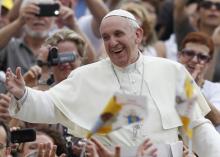
This weekend, more than 800,000 spectators crowded the St. Peter’s Square area while 500,000 more watched on giant screens around Rome as Pope Francis canonized Pope John XXIII and Pope John Paul II. The first time a pope has sainted two popes at the same time, this historic event has been called a savvy political move by the media, since Pope Francis recognized both the more liberal John XXIII and the more conservative John Paul II, thus satisfying two opposing wings of the Roman Catholic church. While Pope Francis did indeed display political savvy at this canonization, this event holds far more significance than that (even leaving aside the spiritual question of discerning sainthood).
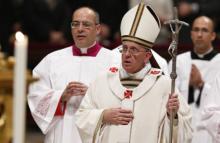
Pope Francis reiterated his strong opposition to abortion on Friday, saying it “compounds the grief of many women” already succumbing to what he called the “pressures of secular culture.”
Francis expressed concern about the challenges the African bishops faced in their communities, from abortion and divorce to violence against women and children.
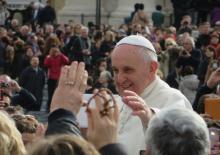
Pope Francis likes to say that he prefers to raise questions rather than issue edicts or change doctrine, and he has certainly generated plenty of debate with his off-the-cuff remarks about gays and his cold-call chats on topics like divorce and Communion, as happened recently with a woman in Argentina.
Now a recent conversation between the pope and a bishop from Brazil about the priest shortage may be moving the issue of married clergy onto the pontiff’s agenda.
During the meeting, Krautler and Francis compared notes on how much the priest shortage affects the church, especially in the Southern Hemisphere. Krautler’s diocese, geographically the largest in Brazil, has just 27 priests for 700,000 Catholics, most of whom might attend Mass a couple of times a year.
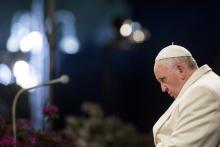
Time magazine has released its annual 100 Most Influential people list, and, to no one's surprise, Pope Francis is featured. What may be surprising is who the magazine chose to write about the pontiff — President Barack Obama. The president points out Pope Francis' dedication to the poor and the "least of these."
In the blurb for Time, Obama says the pope's: "message of love and inclusion, his regard for 'the least of these,' distills the essence of Jesus’ teachings and is a tonic for a cynical age. May we heed his humble example."
Obama recently met with Pope Francis, saying at the Easter Prayer Breakfast:
So I had a wonderful conversation with Pope Francis, mostly about the imperatives of addressing poverty and inequality. And I invited him to come to the United States, and I sincerely hope he will.
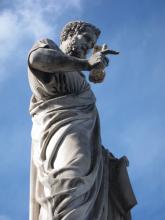
When Pope Francis canonizes Popes John XXIII and John Paul II on Sunday, Catholics across the spectrum will have reason to cheer: Liberals credit John with opening the church to the modern world in the 1960s, and conservatives hail John Paul as reasserting orthodoxy after too many innovations.
But the unprecedented double-barreled canonization also raises a question that might give both sides pause: Why is Rome making saints of almost every modern pontiff after nearly a millennium when almost no popes were canonized?
In the first 500 years of Christianity, the Apostle Peter (considered the first pope by tradition) and 47 of his 48 papal successors were viewed as saints, mainly because so many of them were martyred, which is the simplest route to canonization. Another 30 popes were named saints in the next 500 years, largely based on their reputation for sanctity.

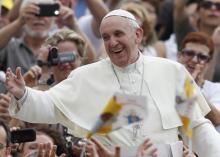
On Thursday evening, in a familiar reprise of an ancient rite, Bishop Robert Morlino of Madison, Wis., will wash the feet of 12 men, all seminarians — a re-creation of Jesus’ action at the Last Supper when he washed the feet of his disciples and, according to Catholic doctrine, formally instituted the priesthood.
That same evening, thousands of miles away, Pope Francis will also observe the Holy Thursday rite, though not in a cathedral like Morlino but at a center for people with disabilities. There he will wash the feet of a number of residents, all lay people and perhaps some of them women and even non-Christians or nonbelievers.
Francis did something similar last year, shortly after his election, when he stunned church observers by traveling to a juvenile detention center outside Rome and washing the feet of 12 young people, two of them women and two of them Muslims.
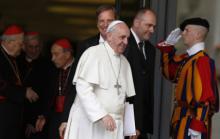
In his strongest personal remarks yet on the clergy sex abuse scandal, Pope Francis on Friday asked forgiveness “for the damage” that abusive priests have inflicted on children and pledged that the Catholic Church “will not take one step backward” in efforts to address the crisis.
“I feel compelled to personally take on all the evil that some priests — quite a few in number, though not compared to the total number — and to ask for forgiveness for the damage they have done by sexually abusing children,” Francis said.
“The church is aware of this damage,” he said. “It is personal and moral damage, but carried out by men of the church. And we do not want to take one step backward in dealing with this problem and the sanctions that must be imposed. On the contrary, I believe that we have to be very firm. Because you cannot take chances with children!”

The news that Pope Francis fired — or “accepted the resignation of” — the German churchman known as “Bishop Bling” because of his big-spending ways has touched off speculation among Catholics that other dismissals could be in the offing.
Here’s the answer in four words: Perhaps, but probably not.
Recent history shows why: Bishop Robert Finn of Kansas City, Mo., remains in office 18 months after his conviction – and $1.4 million spent on his defense — for failing to report a priest suspected of abuse. Los Angeles Cardinal Roger Mahony enjoys a high-profile retirement in spite of the disapproval of his own successor over Mahony’s abuse record. Similarly, Cardinal Bernard Law, formerly of Boston, is still living a gilded existence in Rome years after he was plucked from the U.S. amid the clergy abuse scandal.

Thirty years ago, when the United States established full diplomatic relations with the Holy See, critics of the move fell into two camps.
One group worried that the Vatican would try to unduly influence the U.S., where anti-Catholicism lies barely beneath the skin. Indeed, Harvard historian Arthur Schlesinger Sr. once called anti-Catholicism “the deepest bias of the American people.” Poet Peter Viereck of Mount Holyoke College called anti-Catholicism “the anti-Semitism of the intellectuals.”
Those in the other camp worried that the U.S. would try to unduly influence the Vatican. They complained, for example, that the U.S. would lobby the Vatican’s Pontifical Academy of Sciences to make it refrain from criticizing the now barely remembered Star Wars program, which the U.S. was promoting in the 1980s as part of our national defense system.
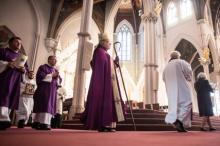
An Irish woman who was a victim of sexual abuse as a child is among eight members of a special commission appointed by Pope Francis on Saturday to start the long and arduous process of confronting the church’s chronic sexual abuse problems.
The creation of the commission is one of the strongest steps Francis has taken to confront the problem that has severely stained the church’s reputation and cost it billions in court settlements and legal fees. The pontiff has called the issue of sexual abuse “the shame of the church” and vowed to take strong steps to confront the issue.

When President Obama and Pope Francis sit down at the Vatican on Thursday, the meeting may well offer a vision of what could have been for Democrats and the Catholic Church over the last six years: a leader of the state and a leader of the church working on the many issues where they agree while working through the issues where they don’t.
Of course, that’s not exactly how it’s gone for Obama and the U.S. hierarchy, even though Obama and the church both stress economic justice and the priority of the common good, universal health care, robust government support for the needy and comprehensive immigration reform.
The potential for a robust alliance fizzled almost from the start of Obama’s candidacy in 2007, and a relationship that began badly went downhill when he was elected.

President Obama is to meet Pope Francis for the first time next week as Obama wraps up a European tour, a high-profile encounter between two major world leaders that appears to carry especially high stakes from the U.S. perspective.
The White House and the American bishops have been at loggerheads for years on a range of culture war issues, and on Tuesday, just two days before the Vatican meeting, the U.S. Supreme Court will hear oral arguments on the contraception mandate that has sparked fierce opposition from the U.S. hierarchy.
But American and Vatican officials say the talks may disappoint those hoping for fireworks, and that the summit is going to focus on collaboration much more than conflict.

The Vatican said Monday that Pope Francis will preside over a prayer vigil dedicated to victims of mob violence in Italy and their families.
The special service, to be held Friday, is expected to include at least 700 Italians who lost a family member to violence connected to Italy’s various organized crime organizations.
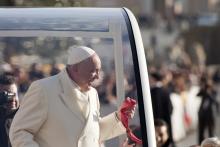
A year ago yesterday — March 13, 2013 — Pope Francis officially became pope. Since then he has fascinated the world.
He didn’t don the snazzy red shoes and fancy papal attire. He chose a humble apartment rather than the posh papal palace. He washed the feet of women in prison. He touched folks that others did not want to touch, like a man with a disfigured face, making headline news around the world. He has put the margins in the spotlight. He refused to condemn sexual minorities saying, “Who am I to judge?” He has let kids steal the show, allowing one little boy to wander up on stage and stand by him as he preached.


Today the world celebrates Pope Francis’ first year. Notice I didn’t say the church is celebrating, but the world. The pope has graced the covers of every magazine from TIME to Rolling Stone over the past year. People all over the world are delighted by the breath of fresh air he has brought. His popularity has moved beyond Catholics to Christians of all kinds, believers from other faith traditions, agnostics, and the “nones,” who are very drawn to this pope who emphasizes love and simple living.
But the pope said last week that he is not a “ superman” and does not want to be a celebrity. He is just trying to talk and live like Jesus, a point he makes repeatedly to shrug off his media darling standing. From the moment he took the name Francis, he made clear his, and thus the church’s priorities: the poor, peace, and the creation. Francis is now challenging the most powerful people and places in the world, as well as a popular culture that mostly asks how we can serve ourselves.
Pope Francis is right: it is not about him; it’s about the Christ he follows. Everything Francis is saying and doing is aimed at pressing this question: Are Christians going to follow Jesus or not? That should be the question on the first anniversary of this new pope. Are we Christians ready and willing to follow Jesus? How can we then serve the world?

So what’s it like to come to work every day when your boss is the pope?
Much also depends on whether you are one of the approximately 3,500 (mostly Italian) lay people in the Vatican’s workforce or one of the 1,100 or so cardinals, bishops, priests, or religious brothers and sisters who tend to occupy decision-making positions and are deeply invested in the policies that Francis adopts.
That second group, often defined by their ideologies and rivalries, tends to draw the most attention, given the high stakes and fierce passions involved.

Figuring out why Pope Francis has upended so many expectations, how exactly he’s changed the Catholic Church in his first year and what he might be contemplating for the future has become a Catholic parlor game that is almost as popular as the pontiff himself.
A single key can best answer all of these questions: Francis’ longstanding identity as a Jesuit priest.
It’s an all-encompassing personal and professional definition that the former Cardinal Jorge Bergoglio brought with him from Buenos Aires, and one that continues to shape almost everything he does as Pope Francis.
“He may act like a Franciscan but he thinks like a Jesuit,” quipped the Rev. Thomas Reese, a fellow Jesuit who is a columnist for National Catholic Reporter.